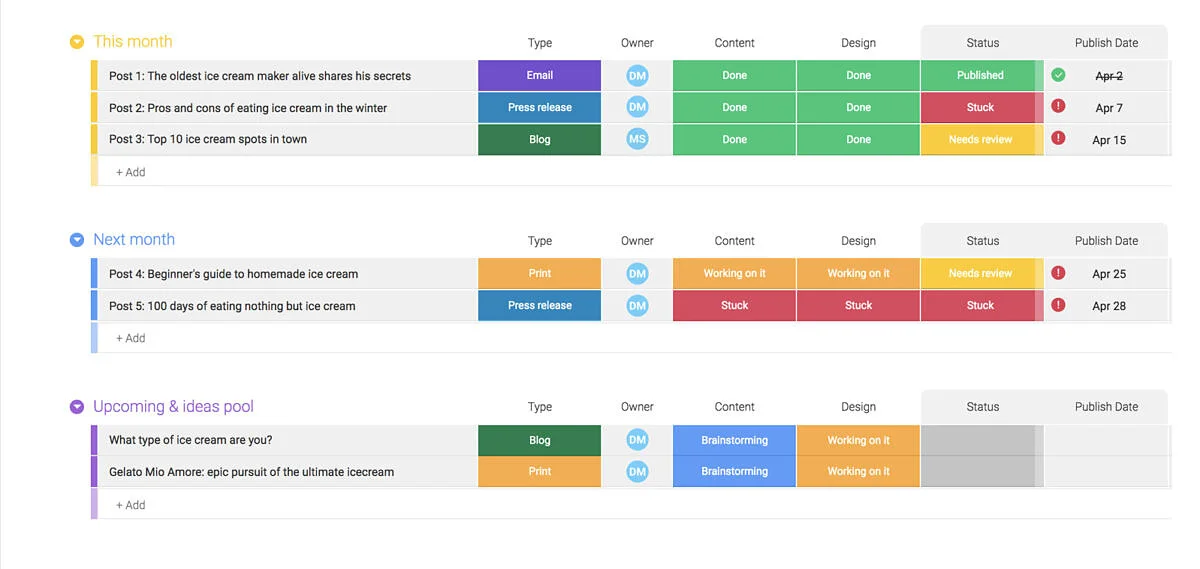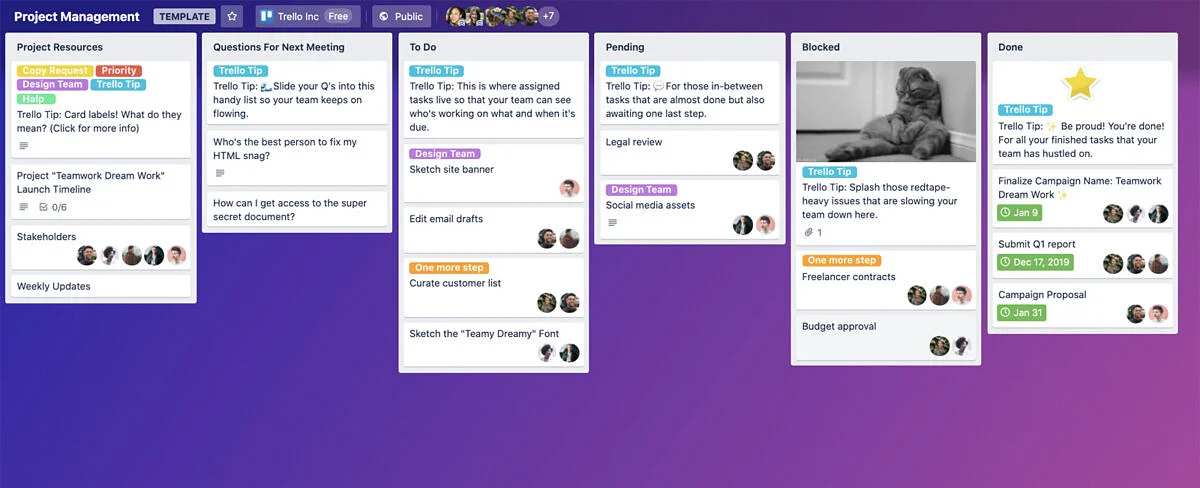Agile project management: A comparison of 5 practical tools and apps
It took just a few years for agile project management to establish itself as a standard in software development. Here you will find out which five software tools and apps ideally map and support the processes involved in agile project management.

What are the requirements a tool for agile project management has to meet?
No longer confined to software and product development, agility has established itself as a cross-departmental working culture. The basic idea of agile project management is to break complex processes and workflows down into clear units before then iteratively working through these units in small teams. The goal is to reduce the complexity of a major project, keep the planning and communication effort involved low and structured, and boost participants’ motivation through rapidly visible progress.
Because project complexity and structure, as well as workflows, are highly individual and variable factors, the software or app used to manage them should be flexibly scalable and adjustable. The software or app must also fit the respective needs and workflows involved. Only then will it ideally reflect the key challenges of a project and support your entire team in the effort to address these needs and workflows. The main challenges involved are:
- Communication: Sharing and assigning tasks, sharing feedback and updates in real time, permitting collaboration on a project segment without having to resort to other software components for the provisioning of work material or the exchange of information
- Analysis: Identifying bottlenecks in workflows, congestion in materials procurement and other obstacles that might arise during the course of the project, performance analysis, financial calculation in real time
- Agile metrics, analytics and reporting: Time recording, forecasting, calculation of scenarios, issuance of progress reports, display of progress status, quality assurance
The following five well-known software tools with their associated apps offer insight into what the entire spectrum of tools for agile project management has to offer: from simple to complex, from specialized to variably deployable across different business areas and applications.

#1 Focused and flexible: Monday
Monday is a project management tool based on the organization and presentation in lists and tables. Tasks are presented colorfully as so-called “pulses” displayed in columns and bundled together in groups. Several groups, in turn, combine to fill a board. Data can be displayed as a timeline in the Gantt chart, as a calendar, as diagrams in charts, as a form or as kanban cards. Monday automatically shows locations as a Google Maps marker, while the Timeline and Calendar views open to reveal effective agile tools for time management.
Monday also offers features for communication and collaboration, both within and across teams. An activity log and a notification system ensure that everyone is up to date. In addition, each pulse offers a discussion area.
- Strengths: All of the elements are freely configurable, making Monday adaptable to each workflow and applicable for different application purposes in project management of different business areas. Corresponding templates – e.g. for the agile sales process, for recruiting, for editorial planning or for office management – are already provided.
- Weaknesses: Despite its colorful design, working with Monday can sometimes seem a bit monotonous due to the tabular structure. In the accompanying app, the display of longer pulses still leaves a bit to be desired. There, it is not possible to capture an entire board at a glance.

#2 Scrum and kanban in feel-good mode: Asana
With Asana, there is nothing left to be desired in terms of user guidance and ease of use, neither in the desktop version nor in the mobile app. For what is actually a comprehensive project-management solution, however, its functional scope does not quite come close to that of many other tools. To begin with, however, the following should be noted: Attractive Gantt charts for appealing and effective time management, visualizations as a kanban board, lists with amazing depth, tables or colored sticky notes, various boards and – last but not least – motivating mythical creatures that dart across the screen: Visually speaking, Asana has everything the heart desires.
To-do lists, project segmentation into sections, effective management through to complex campaigns, schedules and calendars, and even the creation of custom fields make the tool flexibly adaptable to any workflow. The “Inbox,” “Teams” and “Discussions” areas keep each user up to date on all the latest developments and changes. The basic version is available free of charge.
- Strengths: Both kanban and scrum elements come into play in Asana. The capability of integrating Tableau, Salesforce or Adobe Creative Cloud guarantees versatile application of the software for project management across a very wide range of business areas.
- Weaknesses: Some of the details are not available in the same depth seen in more comprehensive tools for project management that use professional IT. Filter functions, for instance, are only limited. However, the simple design of task management has the advantage that all users can concentrate on fulfilling their tasks.

#3 Easy to use for teams of all sizes: Factro
Factro is a SaaS-based software solution for agile project management that, despite its wide range of functions, is convincing for its intuitive user guidance and ease of use. In addition to Gantt charts and kanban board, the software offers the view option as a structure tree. Several projects can also be managed simultaneously without any difficulty. The free basic tariff offers beginners a welcome incentive to sample the high-powered tool at least once. The server is located in Germany, and the app to match the solution is available for mobile use.
- Strengths: The larger-rate packages contains a kanban board, checklists, comment function, notification feed, activity recording, controlling, Gantt charts, multi-project dashboard, scheduling, time tracking, and customer management – in other words, everything that small marketing or sales teams or even IT teams in large organizations need for project management.
- Weaknesses: No internal chat tool is available yet, although this could further simplify communication with other team members. However, the manufacturer has already announced the early implementation of a meeting function.

#4 The specialist for developers: Atlassian Jira
One of the major players and a widely used tool for agile project management in the field of software and product development is Atlassian Jira. The Jira software supports all methods for agile project management, such as scrum and kanban, along with definable hybrid methods, lovingly referred to as “Scrumban” and “Kanplan.” In terms of functional scope, Jira offers everything you need to map, plan, track, manage and simplify your individual projects in a single, agile tool.
Jira is probably the software tool most closely aligned with scrum, with simple backlog management, capabilities for sprint organization, burndown charts, output of sprint reports and epic burndown. On the other hand, with story cards, WIP boundary configuration, swimlanes and board, it also provides ideal mapping of the kanban methodology.
- Strengths: Atlassian Jira is perfectly tailored to the needs of agile project management in the field of software development. An example of this is the release hub that generates warnings in the event of are processes with missing code, faulty build or open pull requests. With the powerful mobile app, the tool can also be optimally used for remote work.
- Weaknesses: Those not working in product or software development will not find a perfect solution in the highly specialized, agile project management tool Jira. The software is also less suitable for smaller teams, since the enormous range of functions has a very negative impact on intuitive usability, especially for beginners.

#5 Kanban compact: Trello
Trello is based on the agile kanban method. As a user, you issue tickets to boards that are flexibly adapted to your own workflow, schedule these, assign them to individual agents or entire teams, populate them with information, checklists and other work materials, and guide them, column by column, through definable process via intuitive, drag-and-drop controls.
- Strengths: Trello is lean and extremely flexible in the design of boards. Handling is child’s play, even for beginners. The range of functions can be expanded considerably by means of external modules. For the organization of smaller teams to entire departments, it comes highly recommended as a tool for agile project management.
- Weaknesses: Trello is not designed for time or cost recording or process optimization. The board view always relates to just one project and does not allow a cross-project overview. That is why it is not suitable for working on complex product-development processes across several smaller teams.





